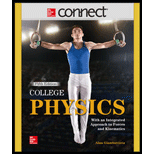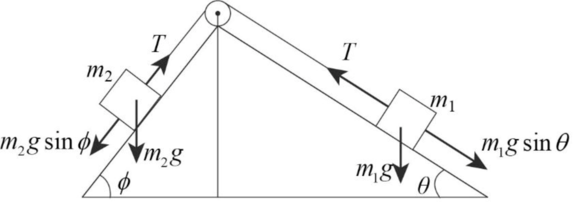
(a)
The velocity of the blocks moving after they travel
(a)
Answer to Problem 133P
The velocity of the blocks moving after they travel
Explanation of Solution
Write the expression for the distance travelled by the first block.
Here,
Write the expression for the distance travelled by the second block.
Here,
Since the mass
Write the expression for the conservation law of energy.
Here,
Use equation (I) and (II) in (III) to solve for
Conclusion:
Substitute
Therefore, the velocity of the blocks moving after they travel
(b)
The acceleration and velocity of each of the blocks.
(b)
Answer to Problem 133P
The acceleration of each of the blocks is
Explanation of Solution

Write the expression for the Newton’s second law of motion for the mass
Here,
Write the expression for the Newton’s second law of motion for the mass
Here,
Use equation (VI) to solve for
Use equation (VII) in (V) to solve for
Initially the blocks are kept stationary and the initial velocity is zero.
Write the equation of motion to solve for the
Here,
Conclusion:
Substitute
Substitute
Therefore, the acceleration of each of the blocks is
Want to see more full solutions like this?
Chapter 6 Solutions
COLLEGE PHYSICS-CONNECT ACCESS
- 2nd image is the same for all drop downsarrow_forwardA mobile is constructed of light rods, light strings, and beach souvenirs as shown in the figure below. If m4 = 12.0 g, find values (in g) for the following. (Let d₁ = 3.20 cm, d₂ = 5.10 cm, d3 = 1.00 cm, d4 = 5.80 cm, d5 = 2.40 cm, and d6 = 3.20 cm.) d₁ d2 d3 d4 Mg d5 d6 mg MA mi (a) m₁ = g (b) m2 = (c) m3 = g g (d) What If? If m₁ accidentally falls off and shatters when it strikes the floor, the rod holding m will move to a vertical orientation so that m hangs directly below the end of the rod supporting m₂. To what values should m₂ equilibrium and be oriented horizontally? (Enter your answers in g.) m2 = m3 = and m3 be adjusted so that the other two rods will remain inarrow_forwardAn automobile tire is shown in the figure below. The tire is made of rubber with a uniform density of 1.10 × 103 kg/m³. The tire can be modeled as consisting of two flat sidewalls and a tread region. Each of the sidewalls has an inner radius of 16.5 cm and an outer radius of 30.5 cm as shown, and a uniform thickness of 0.600 cm. The tread region can be approximated as having a uniform thickness of 2.50 cm (that is, its inner radius is 30.5 cm and outer radius is 33.0 cm as shown) and a width of 19.2 cm. What is the moment of inertia (in kg . m²) of the tire about an axis perpendicular to the page through its center? 33.0 cm 30.5 cm kg. m² 16.5 cm Sidewall Treadarrow_forward
- John is pushing his daughter Rachel in a wheelbarrow when it is stopped by a brick 8.00 cm high (see the figure below). The handles make an angle of 0 = 17.5° with the ground. Due to the weight of Rachel and the wheelbarrow, a downward force of 403 N is exerted at the center of the wheel, which has a radius of 16.0 cm. Assume the brick remains fixed and does not slide along the ground. Also assume the force applied by John is directed exactly toward the center of the wheel. (Choose the positive x-axis to be pointing to the right.) i (a) What force (in N) must John apply along the handles to just start the wheel over the brick? N (b) What is the force (magnitude in kN and direction in degrees clockwise from the -x-axis) that the brick exerts on the wheel just as the wheel begins to lift over the brick? magnitude direction kN ° clockwise from the -x-axisarrow_forwardYour neighbor designs automobiles for a living. You are fascinated with her work. She is designing a new automobile and needs to determine how strong the front suspension should be. She knows of your fascination with her work and your expertise in physics, so she asks you to determine how large the normal force on the front wheels of her design automobile could become under a hard stop, when the wheels are locked and the automobile is skidding on the road. She gives you the following information. The mass of the automobile is m₂ = 1.10 × 103 kg and it can carry five passengers of average mass m = 80.0 kg. The front and rear wheels are separated by d = 4.45 m. The center of mass of the car carrying five passengers is dCM = 2.25 m behind the front wheels and hCM = 0.630 m above the roadway. A typical coefficient of kinetic friction between tires and roadway is μk = 0.840. (Caution: The braking automobile is not in an inertial reference frame. Enter the magnitude of the force in N.) Narrow_forwardThree solid, uniform boxes are aligned as in the figure below. Find the x- and y-coordinates (in m) of the center of mass of the three boxes, measured from the bottom left corner of box A. (Consider the three-box system.) HINT 0.200 m 0.280 m 0.120 m y A B C 0.350 m Origin 0.750 kg 1.00 kg 0.650 kg Х ст E m m Уст xarrow_forward
- Consider the truss shown in the figure, built from three struts attached by three pins. The truss supports a downward force of F = 1,080 N applied at the point B. Assume the mass of the truss is negligible, the pins are frictionless, and the supports at A and C are also frictionless. 01 F B nc 02 C (a) Assuming 0₁ = 26.0° and 0 2 = 51.0°, what are n and n? (Enter the magnitudes in N.) ΠΑ пс = = N N (b) The force any strut applies on a pin must be directed along the length of the strut as a force of tension or compression. What are the directions of the forces that the struts exert on the pins joining them? strut AB on joint A: ---Select--- strut AB on joint B: strut BC on joint B: strut BC on joint C: strut AC on joint A: strut AC on joint C: |---Select--- --Select--- --Select--- --Select--- |---Select--- ✓ ✓ ✓ Find the force of tension or of compression (in N) in each of the three struts. bar AB N N bar BC bar AC Narrow_forwardThe center of mass of the arm shown in the figure is at point A. Find the magnitudes (in N) of the tension force F+ and the force Fs which hold the arm in equilibrium. (Let = 22.5°.) Assume the weight of the arm is 34.8 N. N |Fsl N F 8.00 cm -29.0 cm iarrow_forwardHi, Please type the whole transcript correctly using comma and periods and as needed. Please mention the name of each scientist says. The picture of a video on YouTube has been uploaded down.arrow_forward
- The triangular coil of wire in the drawing is free to rotate about an axis that is attached along side AC. The current in the loop is 4.64 A, and the magnetic field (parallel to the plane of the loop and side AB) is B = 2.1 T. (a) What is the magnetic moment of the loop, and (b) what is the magnitude of the net torque exerted on the loop by the magnetic field? 55.0° 109 B B 2.00 m.arrow_forwardThe triangular coil of wire in the drawing is free to rotate about an axis that is attached along side AC. The current in the loop is 4.64 A, and the magnetic field (parallel to the plane of the loop and side AB) is B = 2.1 T. (a) What is the magnetic moment of the loop, and (b) what is the magnitude of the net torque exerted on the loop by the magnetic field?arrow_forward12 volt battery in your car supplies 1700 Joules of energy to run the headlights during a particular nighttime drive. How much charge must have flowed through the battery to provide this much energy? Give your answer as the number of Coulombs.arrow_forward
 College PhysicsPhysicsISBN:9781305952300Author:Raymond A. Serway, Chris VuillePublisher:Cengage Learning
College PhysicsPhysicsISBN:9781305952300Author:Raymond A. Serway, Chris VuillePublisher:Cengage Learning University Physics (14th Edition)PhysicsISBN:9780133969290Author:Hugh D. Young, Roger A. FreedmanPublisher:PEARSON
University Physics (14th Edition)PhysicsISBN:9780133969290Author:Hugh D. Young, Roger A. FreedmanPublisher:PEARSON Introduction To Quantum MechanicsPhysicsISBN:9781107189638Author:Griffiths, David J., Schroeter, Darrell F.Publisher:Cambridge University Press
Introduction To Quantum MechanicsPhysicsISBN:9781107189638Author:Griffiths, David J., Schroeter, Darrell F.Publisher:Cambridge University Press Physics for Scientists and EngineersPhysicsISBN:9781337553278Author:Raymond A. Serway, John W. JewettPublisher:Cengage Learning
Physics for Scientists and EngineersPhysicsISBN:9781337553278Author:Raymond A. Serway, John W. JewettPublisher:Cengage Learning Lecture- Tutorials for Introductory AstronomyPhysicsISBN:9780321820464Author:Edward E. Prather, Tim P. Slater, Jeff P. Adams, Gina BrissendenPublisher:Addison-Wesley
Lecture- Tutorials for Introductory AstronomyPhysicsISBN:9780321820464Author:Edward E. Prather, Tim P. Slater, Jeff P. Adams, Gina BrissendenPublisher:Addison-Wesley College Physics: A Strategic Approach (4th Editio...PhysicsISBN:9780134609034Author:Randall D. Knight (Professor Emeritus), Brian Jones, Stuart FieldPublisher:PEARSON
College Physics: A Strategic Approach (4th Editio...PhysicsISBN:9780134609034Author:Randall D. Knight (Professor Emeritus), Brian Jones, Stuart FieldPublisher:PEARSON





